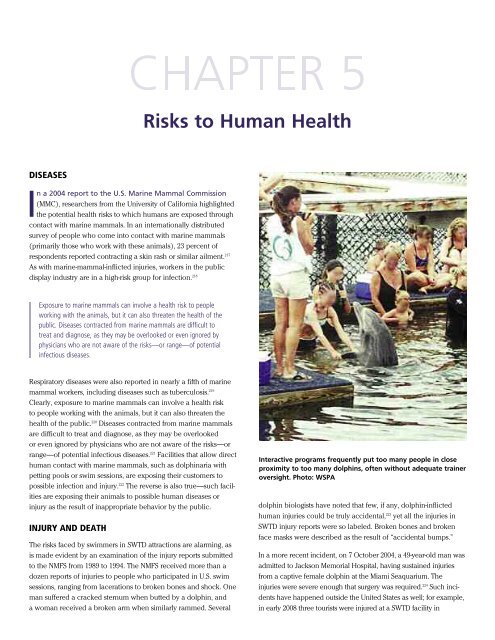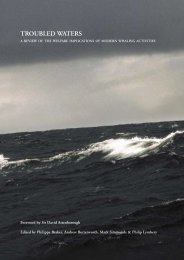Risks to Human HealthDISEASESIn a 2004 report to the U.S. <strong>Mar<strong>in</strong>e</strong> Mammal Commission(MMC), researchers from the University of California highlightedthe potential health risks to which humans are exposed throughcontact with mar<strong>in</strong>e mammals. In an <strong>in</strong>ternationally distributedsurvey of people who come <strong>in</strong>to contact with mar<strong>in</strong>e mammals(primarily those who work with these animals), 23 percent ofrespondents reported contract<strong>in</strong>g a sk<strong>in</strong> rash or similar ailment. 217As with mar<strong>in</strong>e-mammal-<strong>in</strong>flicted <strong>in</strong>juries, workers <strong>in</strong> the publicdisplay <strong>in</strong>dustry are <strong>in</strong> a high-risk group for <strong>in</strong>fection. 218Exposure to mar<strong>in</strong>e mammals can <strong>in</strong>volve a health risk to peoplework<strong>in</strong>g with the animals, but it can also threaten the health of thepublic. Diseases contracted from mar<strong>in</strong>e mammals are difficult totreat and diagnose, as they may be overlooked or even ignored byphysicians who are not aware of the risks—or range—of potential<strong>in</strong>fectious diseases.Respiratory diseases were also reported <strong>in</strong> nearly a fifth of mar<strong>in</strong>emammal workers, <strong>in</strong>clud<strong>in</strong>g diseases such as tuberculosis. 219Clearly, exposure to mar<strong>in</strong>e mammals can <strong>in</strong>volve a health riskto people work<strong>in</strong>g with the animals, but it can also threaten thehealth of the public. 220 Diseases contracted from mar<strong>in</strong>e mammalsare difficult to treat and diagnose, as they may be overlookedor even ignored by physicians who are not aware of the risks—orrange—of potential <strong>in</strong>fectious diseases. 221 Facilities that allow directhuman contact with mar<strong>in</strong>e mammals, such as dolph<strong>in</strong>aria withpett<strong>in</strong>g pools or swim sessions, are expos<strong>in</strong>g their customers topossible <strong>in</strong>fection and <strong>in</strong>jury. 222 <strong>The</strong> reverse is also true—such facilitiesare expos<strong>in</strong>g their animals to possible human diseases or<strong>in</strong>jury as the result of <strong>in</strong>appropriate behavior by the public.INJURY AND DEATH<strong>The</strong> risks faced by swimmers <strong>in</strong> SWTD attractions are alarm<strong>in</strong>g, asis made evident by an exam<strong>in</strong>ation of the <strong>in</strong>jury reports submittedto the NMFS from 1989 to 1994. <strong>The</strong> NMFS received more than adozen reports of <strong>in</strong>juries to people who participated <strong>in</strong> U.S. swimsessions, rang<strong>in</strong>g from lacerations to broken bones and shock. Oneman suffered a cracked sternum when butted by a dolph<strong>in</strong>, anda woman received a broken arm when similarly rammed. SeveralInteractive programs frequently put too many people <strong>in</strong> closeproximity to too many dolph<strong>in</strong>s, often without adequate tra<strong>in</strong>eroversight. Photo: WSPAdolph<strong>in</strong> biologists have noted that few, if any, dolph<strong>in</strong>-<strong>in</strong>flictedhuman <strong>in</strong>juries could be truly accidental, 223 yet all the <strong>in</strong>juries <strong>in</strong>SWTD <strong>in</strong>jury reports were so labeled. Broken bones and brokenface masks were described as the result of “accidental bumps.”In a more recent <strong>in</strong>cident, on 7 October 2004, a 49-year-old man wasadmitted to Jackson Memorial Hospital, hav<strong>in</strong>g susta<strong>in</strong>ed <strong>in</strong>juriesfrom a captive female dolph<strong>in</strong> at the Miami Seaquarium. <strong>The</strong><strong>in</strong>juries were severe enough that surgery was required. 224 Such <strong>in</strong>cidentshave happened outside the United States as well; for example,<strong>in</strong> early 2008 three tourists were <strong>in</strong>jured at a SWTD facility <strong>in</strong>
Curaçao. <strong>The</strong> facility tried to downplay this <strong>in</strong>cident and describedit to local media as a “bump”; however, a digital record<strong>in</strong>g by abystander showed the dolph<strong>in</strong> breach<strong>in</strong>g (a breach is a leap out ofMembers of the public have been observed hold<strong>in</strong>g children andbabies over the heads of dolph<strong>in</strong>s at pett<strong>in</strong>g pools, oblivious to thefact that dolph<strong>in</strong>s can and will bite, not to mention the risk of fall<strong>in</strong>g<strong>in</strong>to the pool.the water, with the animal land<strong>in</strong>g on his or her side on the water’ssurface) <strong>in</strong> a manner that seemed quite deliberate. <strong>The</strong> dolph<strong>in</strong>landed directly on the swimmers, result<strong>in</strong>g <strong>in</strong> a significant impact. 225It is disturb<strong>in</strong>g that the personnel at SWTD attractions claim thatalmost all <strong>in</strong>jurious human-dolph<strong>in</strong> <strong>in</strong>teractions are accidentswhen experts on dolph<strong>in</strong> behavior express skepticism about theiraccidental nature. Clearly the public has an image of the dolph<strong>in</strong>as friendly and gentle, and <strong>in</strong> several SWTD <strong>in</strong>jury reports the victimsexpressed a feel<strong>in</strong>g of responsibility for the <strong>in</strong>cidents <strong>in</strong> question.However, mar<strong>in</strong>e mammals are clearly capable of <strong>in</strong>flict<strong>in</strong>g<strong>in</strong>juries and even kill<strong>in</strong>g humans. It seems a wise precautionbefore the beg<strong>in</strong>n<strong>in</strong>g of a swim session to disabuse participants ofthe myth that dolph<strong>in</strong>s would never deliberately harm a person,yet this does not seem to be occurr<strong>in</strong>g.<strong>The</strong> fact is that at any time dur<strong>in</strong>g a swim session, especially onethat is not controlled, dolph<strong>in</strong>s may <strong>in</strong>flict m<strong>in</strong>or to serious <strong>in</strong>jurieson swimmers for various reasons, some of which are neither obviousnor predictable. Even <strong>in</strong> controlled swim sessions, the risk isOrcas and dolph<strong>in</strong>s have many sharp teeth and are capableof <strong>in</strong>flict<strong>in</strong>g serious wounds on humans with little effort.Photo: ©Pa<strong>in</strong>et, Inc./Ann Purcellalways present and is potentially lethal. It is probable that a personwill eventually be killed <strong>in</strong> these programs, more likely <strong>in</strong> one ofthe many new facilities <strong>in</strong> the develop<strong>in</strong>g world be<strong>in</strong>g built andoperated by entrepreneurs who know little about dolph<strong>in</strong>s butanticipate a large profit from this lucrative tourist activity. This hassignificant implications for the dolph<strong>in</strong>s as well. Should an animalbe <strong>in</strong>volved <strong>in</strong> a seriously <strong>in</strong>jurious or fatal <strong>in</strong>teraction, he or shewould certa<strong>in</strong>ly be removed from the attraction and would facean uncerta<strong>in</strong> fate.<strong>The</strong>re is also a risk that pett<strong>in</strong>g pool dolph<strong>in</strong>s will <strong>in</strong>flict <strong>in</strong>juries onmembers of the public. Frequent teas<strong>in</strong>g by visitors and other <strong>in</strong>appropriatebehavior, such as touch<strong>in</strong>g sensitive areas of the dolph<strong>in</strong>’sbody, like the eyes or blowhole, <strong>in</strong>crease the likelihood ofaggression by the dolph<strong>in</strong>s. Members of the public have even beenobserved hold<strong>in</strong>g children and babies over the heads of dolph<strong>in</strong>sat pett<strong>in</strong>g pools, oblivious to the fact that dolph<strong>in</strong>s can and willbite, not to mention the risk of fall<strong>in</strong>g <strong>in</strong>to the pool. 226Despite their portrayal by the public display <strong>in</strong>dustry as happy,friendly, and playful animals, mar<strong>in</strong>e mammals are—with theexception of the manatee and dugong (Dugong dugon)—predators.Moreover, <strong>in</strong> the wild, their behavior to conspecifics andother mar<strong>in</strong>e mammals is often aggressive—and sometimes violent.For example, bottlenose dolph<strong>in</strong>s, the most commonly keptcetacean species <strong>in</strong> captivity, have been regularly reported attack<strong>in</strong>gand kill<strong>in</strong>g members of other cetacean species, 227 and evenattack<strong>in</strong>g and kill<strong>in</strong>g conspecifics’ calves. 228 Orcas, anothercommonly kept cetacean, are well known for their predatorybehavior and have been recorded kill<strong>in</strong>g a wide variety ofmar<strong>in</strong>e mammal species. 229Some facilities are now <strong>in</strong>vit<strong>in</strong>g customers to swim with belugas,despite the animals’ large size and the cold temperaturesof their pool water. Photo: BigStockPhoto/Vladimir Wrangel<strong>The</strong> MMC survey from the University of California discoveredthat more than half of mar<strong>in</strong>e mammal workers had been <strong>in</strong>juredby the animals (251 cases altogether). 230 Those <strong>in</strong> regular contactwith mar<strong>in</strong>e mammals or <strong>in</strong>volved with clean<strong>in</strong>g and repair<strong>in</strong>g30
- Page 1 and 2: THE CASE AGAINSTMarine Mammalsin Ca
- Page 3 and 4: Authors: Naomi A. Rose, E.C.M. Pars
- Page 5 and 6: Public display facilities often pro
- Page 7 and 8: IntroductionWhen drafting the Marin
- Page 9 and 10: Education, Conservation, and Resear
- Page 11 and 12: habitat (known as in situ) or in ca
- Page 13 and 14: having a well-organized group is cr
- Page 15 and 16: took advantage of a period of gover
- Page 17 and 18: Unfortunately, captive facilities r
- Page 19 and 20: than this one), even when there are
- Page 21 and 22: Most cutting-edge behavioral resear
- Page 23 and 24: plans are often wholly inadequate).
- Page 25 and 26: sanitation methods that kill vegeta
- Page 27 and 28: A prime example of the inappropriat
- Page 29 and 30: Cetaceans are difficult to diagnose
- Page 31 and 32: allowed to enter the area and dolph
- Page 33: A detailed survey of public display
- Page 37 and 38: The irony of the ocean beckoning ju
- Page 39 and 40: This dolphin has been fitted with a
- Page 41 and 42: The very traits that make dolphins
- Page 43 and 44: The behavior of cetaceans also impl
- Page 45 and 46: Most zoos and aquaria currently obt
- Page 47 and 48: Of at least 193 orcas held in capti
- Page 49 and 50: What replaces, with equal impact, p
- Page 51 and 52: only occurs in areas where there is
- Page 53 and 54: sions. This facility had already co
- Page 55 and 56: The Solomon Islands government has
- Page 57 and 58: S. R. Kellert and J. Dunlap, “Inf
- Page 59 and 60: in May 2006). When one considers th
- Page 61 and 62: paper, from 1954, could be found th
- Page 63 and 64: traits (e.g., docile disposition, s
- Page 65 and 66: cial and non-profit sponsors, and s
- Page 67 and 68: D. A. Carder, “Hearing deficits m
- Page 69 and 70: 154 Stereotypies are generally nega
- Page 71 and 72: y J. P. Schroeder entitled “Breed
- Page 73 and 74: Washington Legal Times, stating tha
- Page 75 and 76: about the welfare of the dolphins a
- Page 77 and 78: 251 Small and DeMaster, “Acclimat
- Page 79 and 80: Pinnipeds and Other Non-Cetaceans28
- Page 81 and 82: held for two years in a tank hidden
















